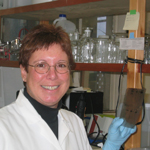Research Identifies Chemical to Reduce Fat Deposition
Media Contact:
Jennifer Martin, (202) 720-8188
By Stacy Kish, CSREES Staff
February 25, 2009

Dr. Quinn exaining biochemical data in her laboratory.
Photo credit: Cynthia Pekow
The New Year is a time of resolutions when many people pledge to lose weight and eat a more healthful diet. This year, scientists may have a new weapon in the arsenal to help people win the battle of the bulge.
A chemical secreted by muscle may control fat deposited in humans and animals, a key factor in the fight against obesity and in the agricultural production of leaner, healthier meat.
Muscle cells release a protein factor, called interleukin-15 (IL-15), which has been shown to reduce the growth of fat cells. Unfortunately, IL-15 is normally released into the bloodstream in small amounts.
With funding from the USDA’s Cooperative State Research, Education, and Extension Service (CSREES), Dr. LeBris Quinn, Dr. Argiles, and colleagues at the at the University of Washington’s School of Medicine and the Department of Veterans Affairs Puget Sound Health Care System in Tacoma, WA, developed mice whose muscles produced higher amounts of IL-15.
The IL-15 mice consumed the same number of calories as a control group, but only put on half as much fat. When placed on a high-fat, high-calorie diet designed to mimic the typical Western diet, the IL-15 mice did not become obese.
The researchers speculate that more IL-15 may be released from the muscles during exercise, which accounts for the increased loss of body fat.
“Muscle tissue produces a lot of IL-15, but it is not released into the bloodstream very efficiently,” Quinn said. “Our study showed that IL-15 has to be released into the circulation to affect fat deposition.”
Reducing the deposition of fat in livestock could be a major economic boon to agriculture if nutrients could be used more efficiently to grow more lean muscle (meat) rather than fat deposition.
On the human side, obesity continues to be a major health concern in the United States.
Previous research conducted in the United States and Europe identified variations in the genes that control interleukin-15 levels in human subjects and correlated these results with susceptibility to obesity and diabetes.
According to the Centers for Disease Control and Prevention (CDC), in the past 30 years the prevalence of overweight and obesity has increased sharply for both adults and children.
In 2005–2006, more than 34 percent of adults aged 20 years or older were obese. The numbers are more startling for children. The percentage of overweight and obese children aged 2 to 5 years increased from 5 percent in 1980 to 14 percent in 2006.
Obesity is associated with an increase in Type 2 diabetes, high blood pressure, heart disease, stroke, degeneration of the cartilage that buffers major joints, sleep apnea, and certain cancers, such as breast and colon cancer.
“All of these conditions increase with age, along with increases in fat tissue and decreases in muscle tissue. My laboratory is currently exploring why IL-15 levels decline with age, and whether maintaining youthful levels of IL-15 will keep laboratory mice healthier and more vital as they age,” Quinn said.
“Just as in humans, it was harder for the gal mice to lose fat than for the guys,” Quinn said. Her team is also exploring whether sex hormones, such as estrogen, play a role in this gender difference.
This work was funded by the CSREES National Research Initiative Animal Growth and Nutrient Utilization program and the National Institutes of Health.
Through federal funding and leadership for research, education and extension programs, CSREES focuses on investing in science and solving critical issues impacting people’s daily lives and the nation’s future. For more information, visit www.csrees.usda.gov.
#






